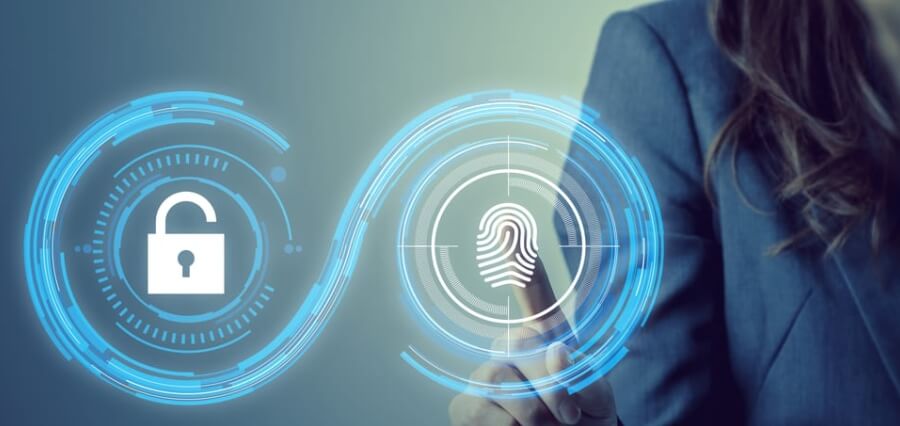As biometric technology becomes more accurate and sophisticated, a growing number of companies have started using it to protect their employees and data.
According to ExpressVPN’s summary, biometrics refers to body measurements and behavior traits unique to every human that can be used to identify and authenticate individuals. Aside from authentication, it’s used for access control, in law enforcement, and other fields related to security and data protection.
One of the most significant advantages of biometric technology is that it relies on our body measurements, which is more convenient to use since we don’t have to memorize whole phrases to access our accounts, and it’s much harder to obtain which is ideal for companies who deal with sensitive data.
HOW BUSINESSES USE BIOMETRICS
- Attendance recording
With biometric technology becoming more sophisticated and accessible, employers started implementing attendance recording tools based on biometric authentication. Biometrics are used to validate whether the employee is present at a specific location at a particular time. For instance, some tools request employees to provide their fingerprints to clock in and out. This has proved to be a more accurate authentication method since biometric information like fingerprints or face scans is difficult to falsify.
- Remote data access
Companies dispose of vast amounts of valuable data that can jeopardize the whole enterprise if it ends up in the wrong hands. In these situations, it’s crucial to grant access to relevant data only to those who need it. Hackers often attempt to steal credentials and access sensitive company documents, but biometric data tends to be a safer option since you can limit the number of employees who have access more easily. If your employees access company data remotely, hackers are more likely to get under the radar since they can disguise themselves as legitimate users and wreak havoc in your system. However, with biometric authentication systems in place, businesses will be better protected when guarding sensitive data.
- Payments
With their convenience and high level of security, biometric payments are leading the way to a brighter financial future. For instance, Visa recently launched a pilot program with a biometric sensor for contactless payment where users have to provide a fingerprint instead of a PIN or signature that has been previously required to verify the cardholder. Simultaneously, some countries are taking biometric payments a step further as they begin implementing the first facial payment systems to make the transactions smoother and more secure. According to financial experts, biometric payments can help businesses keep a better track of their transactions and minimize the risk of fraud.
- Enabling access
Businesses most commonly use biometrics to grant access to buildings. Since the presence of an unknown third party at the company’s premises can pose a severe security risk, providing biometric data like retina scan, fingerprint, or face scan can be an excellent way to limit the potential security issues. Companies that use biometric technology for access control most commonly opt for fingerprints or facial recognition. Despite being a significant investment, the technology itself has improved significantly over the past couple of years, giving companies higher levels of security and fewer frictions.
CHALLENGES OF USING BIOMETRICS IN BUSINESS
They can be compromised
Even though research suggests biometric authentication tends to be more secure and convenient than good old passwords, the biggest issue with biometrics is that once they’re compromised, the difficulty in taking the necessary steps to fix the data leak. You can always change your password or a PIN if you suspect unauthorized activity, but you can’t change your fingerprints or the blood vessel pattern in your retina.
Ethical issues
Many people still don’t trust biometric technology because they fear becoming subject to surveillance and loss of privacy. Another concern is that biometric information may be shared with third parties and used for purposes users never explicitly agreed to. Even though tech companies are solving these issues, many users are still wary of fully embracing biometrics and giving it a key role in their business operations.
HOW TO PROTECT YOUR DATA
Use multi-factor authentication
Even though biometrics are considered safer than passwords and PINs, you can’t do much to protect your assets if they get compromised. Therefore, start using multi-factor authentication to coat our accounts in several layers of protection. Multi-factor authentication most commonly entails a password combined with some biometric factor and a USB stick, card, or token device. This drastically reduces your chances of getting hacked since the perpetrator has to obtain all three authentication factors to access your account.
Organize staff training
If you use the most advanced and sophisticated technology to protect and improve your business, its impact is limited if your employees don’t know how to use it. Ensure proper training for your employees and let them express their opinions and concerns. Their feedback can be essential when implementing new technological solutions.
THE FUTURE OF BIOMETRICS
If we believe the predictions, the biometrics market will be worth more than $55 billion by 2027. Since they’re more convenient and don’t rely on memorization like passwords, business owners are becoming more prone to implementing biometric solutions into their business strategies. We can expect this trend to grow even faster in the future with technology becoming more advanced every day.


